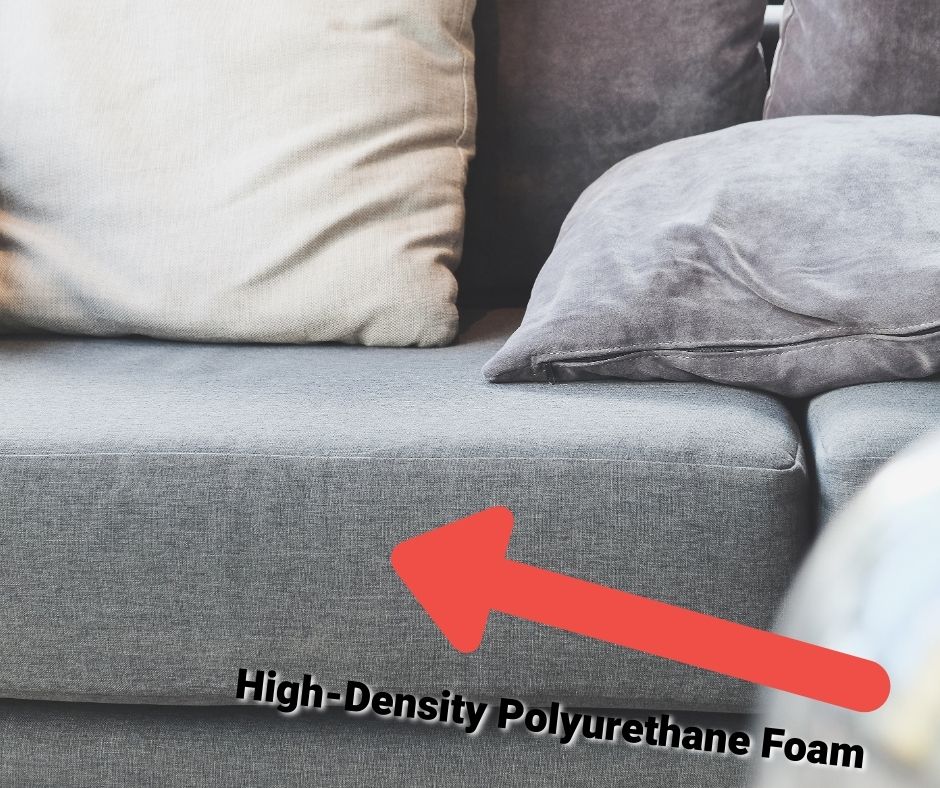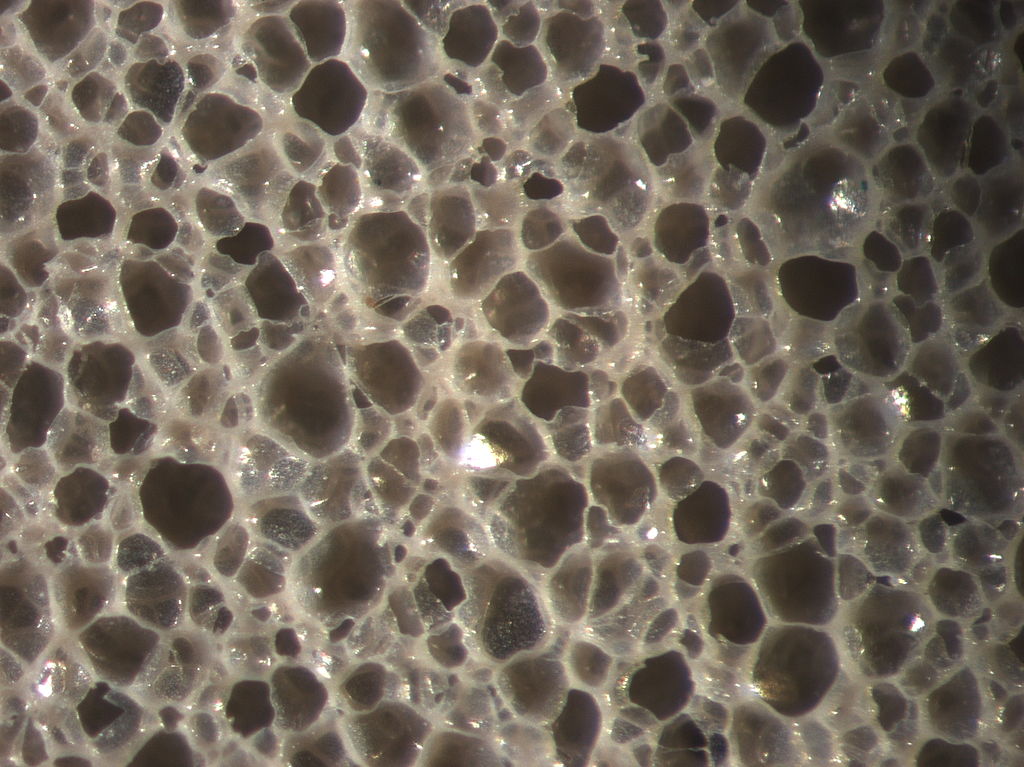Did you know that cheap couch cushions can lose their shape within a year? Instead of buying a new couch, you can simply replace the foam cushions!
It’s a cost-effective project that will breathe new life into your sofa.
In This Article We'll Discuss
What is The Best Foam to Use For Sofa Cushions?

The best foam to use for sofa cushion is high-density polyurethane foam. PU foam is available in different weights and densities. It’s the most popular material for sofas because of its support and comfort. It’s a long lasting foam that can work for 6 years or more.
#1: High-Density Foam
If you want your new cushions to last, high-density foam is the way to go. This firm material is capable of lasting for several years without losing its shape.
In furniture-making, density refers to the amount of material in one cubic foot of foam. You might see this represented a couple of different ways. Some foam manufacturers use a standalone Pound Per Cubic Foot rating while others rely on the standard grading system.
The grading system is a four-digit number. The first two digits of that number designate its density. For example, if the rating was 2836, the “28” represents the density
In that case, the “28” would mean 2.8 pounds.
Generally, anything above 2.5 pounds per cubic foot is high-density. This type of foam will feel firm yet comfortable. It’s always a good option for seat cushions.
For even greater support, you can choose a High Resilience foam. This is a type of foam with a density of 3. pounds per cubic foot or more.
For your back cushions, many recommend going with something slightly softer so that you can sink into the couch. Use the rating system to find something suitable!
#2: High-Compression Foam
Another important specification to consider is the compression rating.
Remember that four-digit number we mentioned earlier? The first two digits represent the density. However, the last two digits give you more insight into how it compresses under a person’s weight.
Those two numbers are the Indentation Load Deflection or ILD rating. This measurement tells you how much weight the foam can take before it compresses down one inch.
In the four-digit rating from earlier, 2836, the ILD would be 36 pounds.
The upholstery fabric that’s covering your seat cushions can affect how much the foam compresses. But, the ILD will give you a better idea of how firm or soft the material is.
A higher ILD will feel firmer. It has more hold and takes more weight to sink down. Meanwhile, a lower rating will compress and conform to the shape of your body. These are best for sofas that need to support two or more people.
The right option for you is up to personal preference! However, most would say that a softer cushion is better. So, you would choose a high-compression foam with a higher ILD rating.
#3: Open-Cell Foam
Open-cell foam is a popular choice for couches because of its softness. As the name would imply, this type of foam has open cells that air can easily move through.
What are the benefits of that? Well, the foam has better compresses more efficiently.
When you sit down, your weight expels the air inside the foam to conform to your body shape. That’s not all.
Open-cell foam products also usually rebound better. The air flows back into those open cells, which restores the original shape of the foam.
This type of foam also has a cooling effect. Thanks to those open pores, air circulates through the material. This can prevent heat buildup.

#4: Basic Polyurethane Foam
Readily available and affordably priced, polyurethane is great for sofa cushions. In fact, it’s the most widely used foam product in the furniture industry. About 90 percent of upholstered pieces use it!
Polyurethane foam, also known as PU foam, comes in many forms. You can get it in multiple density and compression ratings, too.
Without getting into the technical weeds, manufacturers create PU foam out of chemicals that come from crude oil. This includes alcohol called polyol and a compound called Diisocyanates.
When these two chemicals combine, they react to create polyurethane foam.
PU foam is a high-performance material that balances comfort and support.
#5: Latex Foam
Latex foam is another material worth checking out. It costs more than standard PU foam, but it offers a few additional benefits.
The first is its longevity. Latex foams usually outlive polyurethane. That’s because it has fewer chemical compounds that could speed up its breakdown.
It’s also very resilient. The material is naturally quite elastic. Thus, it can spring back and hold its shape for a very long time.
Another big benefit is that is may be more natural than PU foam. We say “may be” because there are a couple of different types of latex foams available. There are those made out of 100 percent natural latex and those made out of synthetic latex.
Natural latex comes from trees and plants! Most think that it only comes from only rubber trees, but latex is present in about 10 percent of all identified plants.
In its natural form, latex is a milky white liquid with an emulsion of suspended polymers.

Synthetic latex has very similar properties to its natural counterpart. Scientists create it with simple molecules. Generally, synthetic latex foams are far more affordable than natural ones.
Latex foam is super dense because of the manufacturing process. For both natural and synthetic latex, the liquid coagulates. The polymers within it link up to give the material its signature elasticity.
Overall, latex is a comfortable material that holds up well. While it may cost more, a well-made cushion is more than capable of lasting decades.
#6: Memory Foam
Want to splurge and create the plushest sofa cushions possible? Memory foam has you covered!
This material can be expensive. But, it’s the best choice in terms of comfort.
Memory foam is a viscoelastic substance. It exhibits viscous properties like a liquid while also providing great elasticity.
This foam works to immediately bounce back after you remove pressure. It’s not like traditional foam where a single point causes compression around the point’s radius. As a result, it conforms to your body perfectly!
Not only that, but memory foam reacts to body heat. It becomes softer when you touch it, improving efficiency and comfort across the board.
The material is dense, supportive, and very comfortable to sit on. It’s also good for your back and muscles.
Memory foam and polyurethane foam go through a similar manufacturing process. However, memory foam has additional chemicals that give it its distinct physical properties.
#7: Poly-Fill
Here’s a more affordable option than traditional foams. Poly-fill is similar to cotton. It’s light, airy, and flexible enough to fine-tune the comfort levels of your cushions.
Poly-fill is not like a traditional foam. It’s a fiber material made out of polyester.
Used more like a filling, this isn’t going to provide you with a ton of support. However, many like to use it in conjunction with denser foams.
You might use it on top of traditional PU foam to create a plusher feel. Underneath the fabric upholstery, the poly-fill will provide more give so that you can sink down into your sofa.
The great thing about poly-fill is that you can easily adjust the firmness of the cushion to meet your needs. Density depends entirely on how you pack it into the cushion, so you can add or remove the material to get things just right.
Conclusion
Did you like our list of foams that you can use in your sofa cushions?
Use these materials to freshen up an old sofa. You can use them to replace the couch’s existing filler material or create new cushions from scratch!
Whatever you decide to do, these foams will provide the support and comfort you need. Let us know what you think in the comments below and don’t forget to share our article if you liked it!

